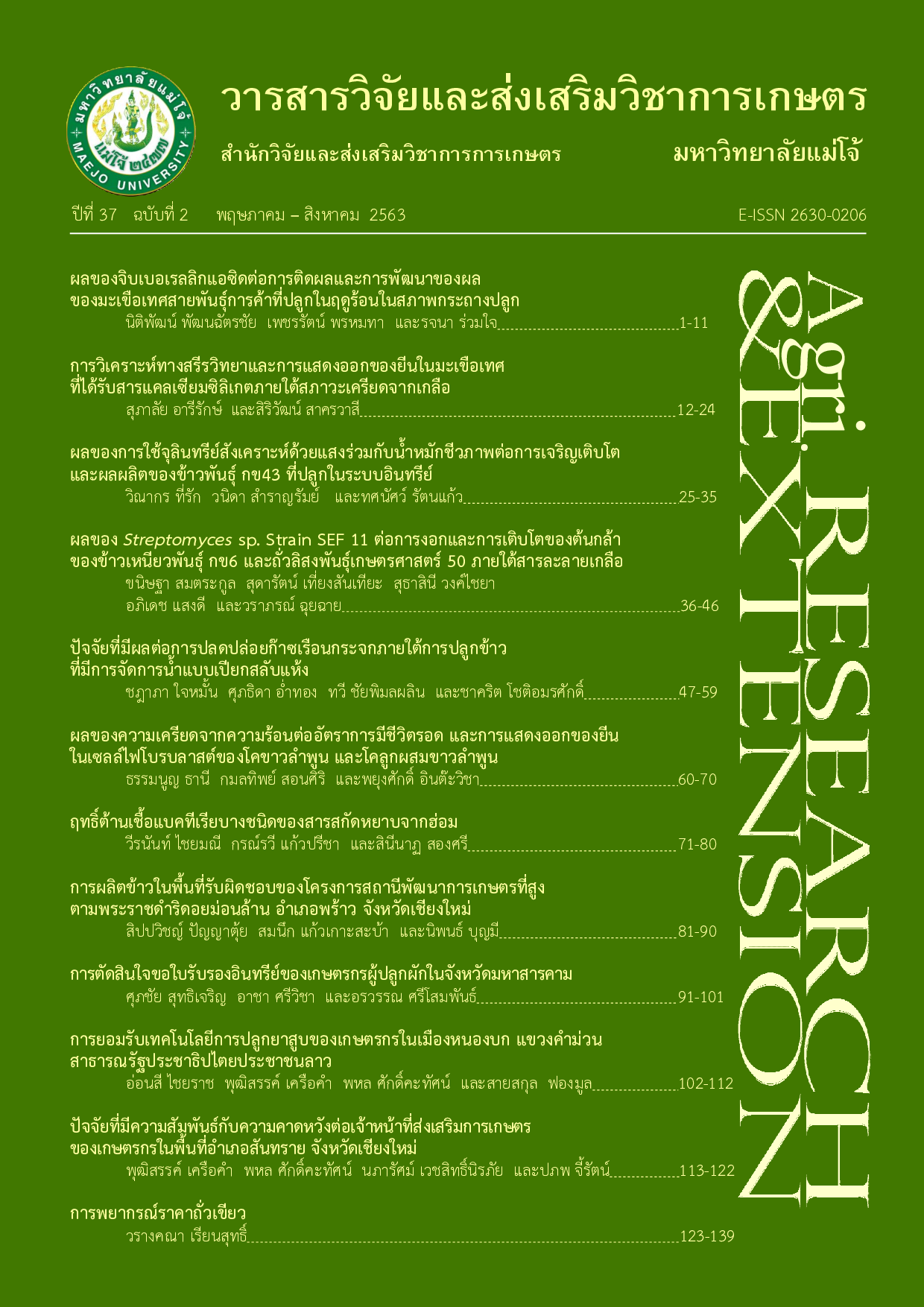ผลของ Streptomyces sp. Strain SEF 11 ต่อการงอกและการเติบโตของต้นกล้า ของข้าวเหนียวพันธุ์ กข 6 และถั่วลิสงพันธุ์เกษตรศาสตร์ 50 ภายใต้สารละลายเกลือ
บทคัดย่อ
การศึกษานี้จัดทำขึ้นเพื่อศึกษาผลของการใช้แบคทีเรียส่งเสริมการเจริญเติบโตของพืช โดยใช้แบคทีเรีย (Streptomyces sp. สายพันธุ์ SEF11) ที่มีความสามารถในการผลิตกรดอินโดลอะซีติกทั้งในรูปของสารแขวนลอยเซลล์แบคทีเรียและน้ำเลี้ยงเซลล์ต่อการงอกและการเจริญเติบโตของต้นกล้าข้าวเหนียวพันธุ์ กข 6 และถั่วลิสงพันธุ์เกษตรศาสตร์ 50 ซึ่งเพาะในสารละลายโซเดียมคลอไรด์ ที่ปราศจากเชื้อ 2 ระดับความเข้มข้น ได้แก่ ระดับความเค็มน้อย (ค่าความนำไฟฟ้า 2.37 เดซิซีเมนส์/เมตร) และระดับความเค็มปานกลาง (ค่าความนำไฟฟ้า 7.25 เดซิ ซีเมนส์/เมตร) ผลการทดลองพบว่า เมล็ดพันธุ์ข้าวเหนียว กข 6 และถั่วลิสงพันธุ์เกษตรศาสตร์ 50 งอกได้ดีที่ระดับความเค็มเล็กน้อยและระดับความเค็มปานกลาง การแช่เมล็ดพันธุ์ในสารแขวนลอยแบคทีเรียส่งผลให้ความยาวยอดของถั่วลิสงพันธุ์เกษตรศาสตร์ 50 และความยาวรากของข้าวเหนียวพันธุ์ กข 6 และถั่วลิสงพันธุ์เกษตรศาสตร์ 50 เพิ่มขึ้น เมื่อเปรียบเทียบกับชุดควบคุมในทุกระดับความเค็ม ส่วนการแช่เมล็ดพันธุ์ในน้ำเลี้ยงเซลล์ส่งผลให้ความยาวยอดและความยาวรากของข้าวเหนียวพันธุ์ กข 6 เพิ่มขึ้นเช่นกันเมื่อเปรียบเทียบกับชุดควบคุม แต่ไม่ ส่งผลต่อถั่วลิสงพันธุ์เกษตรศาสตร์ 50 ดังนั้นจึงมีความเป็นไปได้ที่จะนำ Streptomyces sp. สายพันธุ์ SEF11 ไปใช้ส่งเสริมการเจริญเติบโตของข้าวเหนียวพันธุ์ กข 6 และถั่วเหลืองพันธุ์เกษตรศาสตร์ 50 ในสภาวะดินเค็ม
เอกสารอ้างอิง
Annex 1. n.d. Crop salt tolerance data. [Online]. Available http://www.fao.org/3/y4263e/y4263e0e.htm (23 December 2019).
Arunin, S. and P. Pongwichian 2015. Salt-affected soils and management in Thailand. Bull. Soc. Sea Water Sci. 69: 319-325.
Asim, M., M. Aslam, A. Bano, M. Munir, A. Majeed and S.H. Abbas. 2013. Role of phytohormones in root nodulation and yield of peanut under salt stress. Am. J. Res. Commun. 1: 191-208.
Calvelo Pereira, R.C., C. Monterroso and F. Macias. 2010. Phytotoxicity of hexachlorocyclohexane: effect on germination and early growth of different plant species. Chemosphere 79: 326-333.
Chuanren, D., W. Bochu, L. Wanqian, C. Jing, L. Jie and Z. Huan. 2004. Effect of chemical and physical factors to improve the germination rate of Echinaceae angustifolia seeds. Colloids Surfaces B. 37: 101-105.
Gulnaz, A., J. Iqbal, S. Farooq and F. Azam. 1999. Seed treatment with growth regulators and crop productivity I. 2,4-D as an inducer of salinity-tolerance in wheat (Triticum aestivum L.). Plant and Soil 210: 209-217.
Ilangumaran, G. and D.L Smith. 2017. Plant growth promoting rhizobacteria in amelioration of salinity stress: a systems biology perspective. Front. Plant Sci. 8(1768): 1-14.
Li, H.Q. and X.W. Jiang. 2017. Inoculation with plant growth-promoting bacteria (PGPB) improves salt tolerance of maize seedling. Russ. J. Plant Physl. 64: 235-241.
Machado, R.M.A. and R.P. Serralheiro 2017. Soil salinity: effect on vegetable crop growth management practices to prevent and mitigate. Horticulturae 3(30): 1-13.
Mohamed, H.I. and E.Z. Gomaa. 2012. Effect of plant promoting Bacillus subtilis and Pseudomonas fluorescens on growth and pigment composition of radish plants (Raphanus sativus) under NaCl stress. Photosynthetica 50: 263-272.
Mohr, H. and P. Schopfer. 1995. Plant Physiology. Berlin: Springer. 269 p.
Pan, J., F. Peng, X. Xue, Q. You, W. Zhang, T. Wang and C. Huang. 2019. The growth promotion of two salt-tolerant plant groups with PGPR inoculation: a meta-analysis. Sustainability 11(378): 1-14.
Sarkar, A., P.K. Ghosh, K. Pramanik, S. Mitra, T. Soren, S. Pandey, M.H. Mondal and T.K. Maiti. 2018. A halotolerant Enterobacter sp. displaying ACC deaminase activity promotes rice seedling growth under salt stress. Res. Microbiol. 169: 20-32.
Shirokova, Y., I. Forkutsa and N. Sharafutdinova. 2000. Use of electrical conductivity instead of soluble salts for soil salinity monitoring in Central Asia. Irrig. Drain. Sys. 14: 199-205.
Shrivastava, P. and R. Kumar. 2015. Soil salinity: a serious environmental issue and plant growth promoting bacteria as one of the tools for its alleviation. Saudi J. Biol. Sci. 22: 123-131.
Singh, R.P. and P.N. Jha. 2017. Analysis of fatty acid composition of PGPR Klebsiella sp. SBP-8 and its role in ameliorating salt stress in wheat. Symbiosis 73: 213-222.
Somtrakoon, K., N. Sripasa, S. Ladsena, A. Sangdee and W. Chouychai. 2019. Optimum conditions for indole-3-acetic acid production by Streptomyces and its stimulation on seed germination of rice cv. KDML105. Journal of Agricultural Research and Extension 36(3): 12-22. [in Thai]
Tanimoto, E. 2005. Regulation of root growth by plant hormones–roles for auxin and gibberellin. Cri. Rev. Plant Sci. 24: 249-265.
ดาวน์โหลด
เผยแพร่แล้ว
รูปแบบการอ้างอิง
ฉบับ
ประเภทบทความ
สัญญาอนุญาต
ลิขสิทธิ์ (c) 2020 วารสารวิจัยและส่งเสริมวิชาการเกษตร

อนุญาตภายใต้เงื่อนไข Creative Commons Attribution-NonCommercial-NoDerivatives 4.0 International License.
บทความนี้ได้รับการเผยแพร่ภายใต้สัญญาอนุญาต Creative Commons Attribution-NonCommercial-NoDerivatives 4.0 International (CC BY-NC-ND 4.0) ซึ่งอนุญาตให้ผู้อื่นสามารถแชร์บทความได้โดยให้เครดิตผู้เขียนและห้ามนำไปใช้เพื่อการค้าหรือดัดแปลง หากต้องการใช้งานซ้ำในลักษณะอื่น ๆ หรือการเผยแพร่ซ้ำ จำเป็นต้องได้รับอนุญาตจากวารสาร





